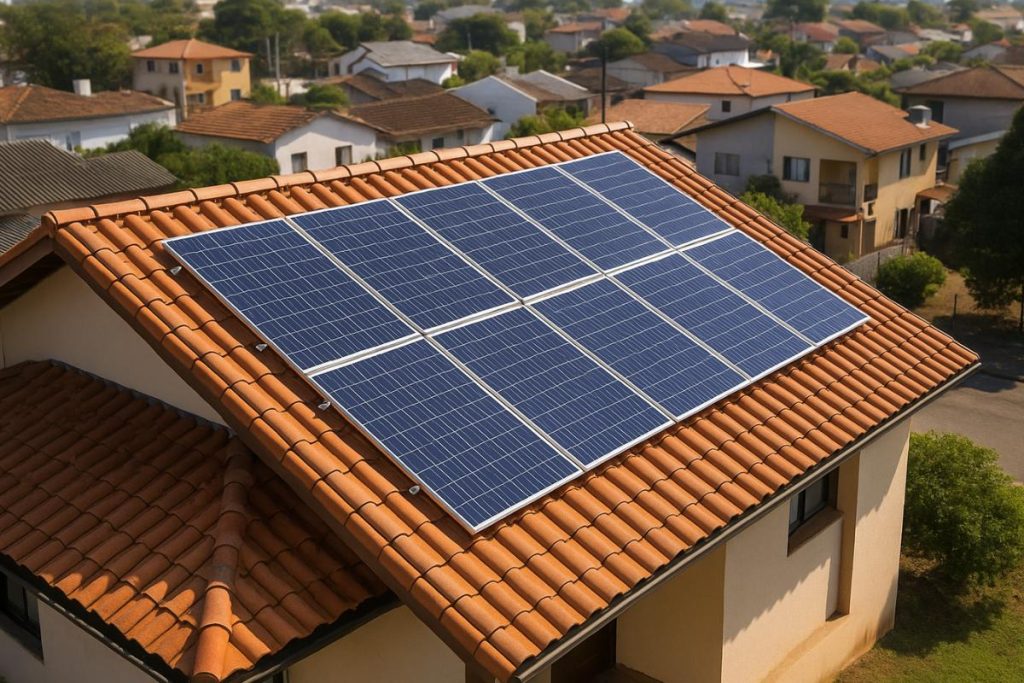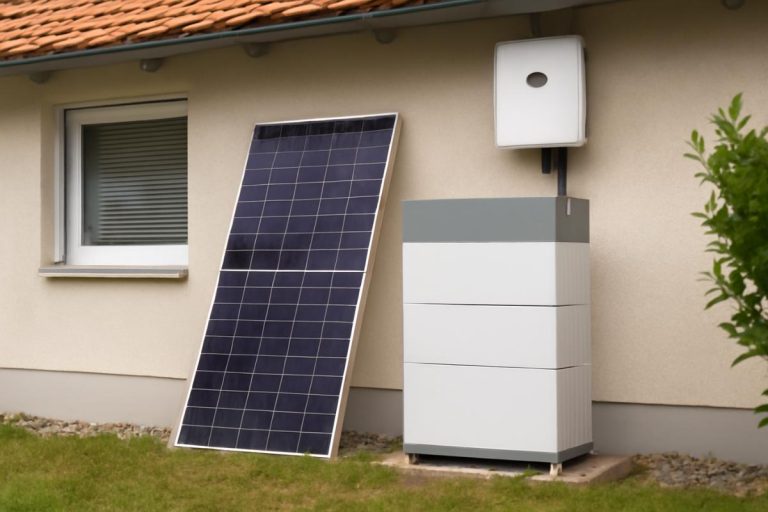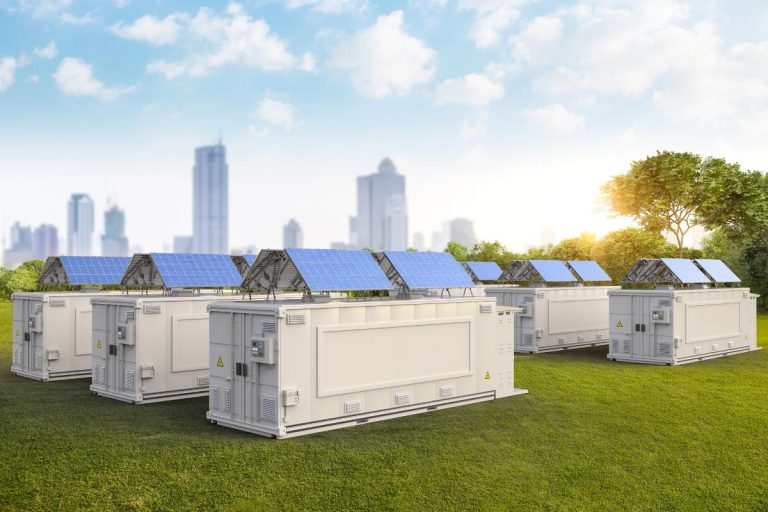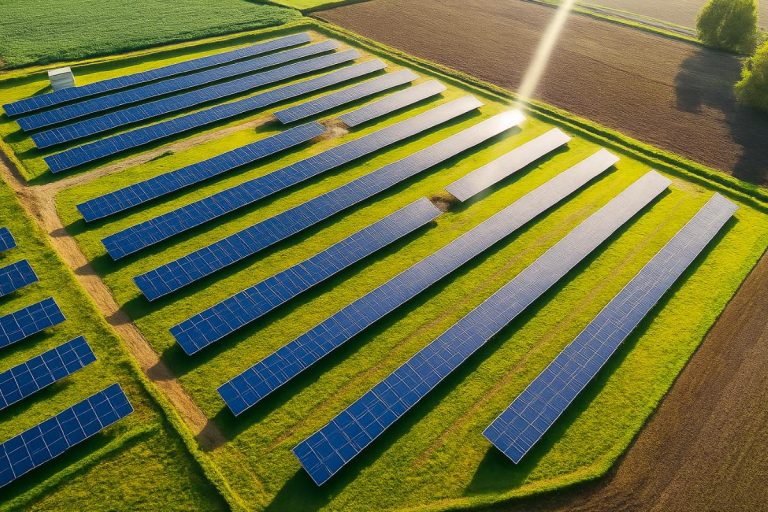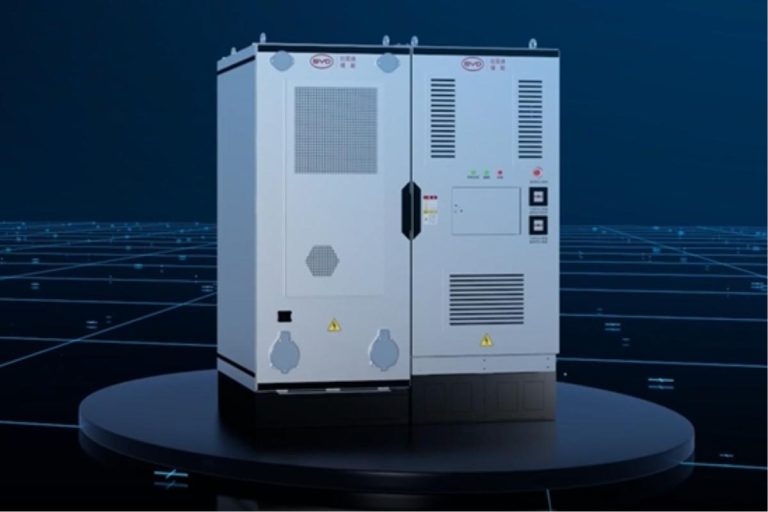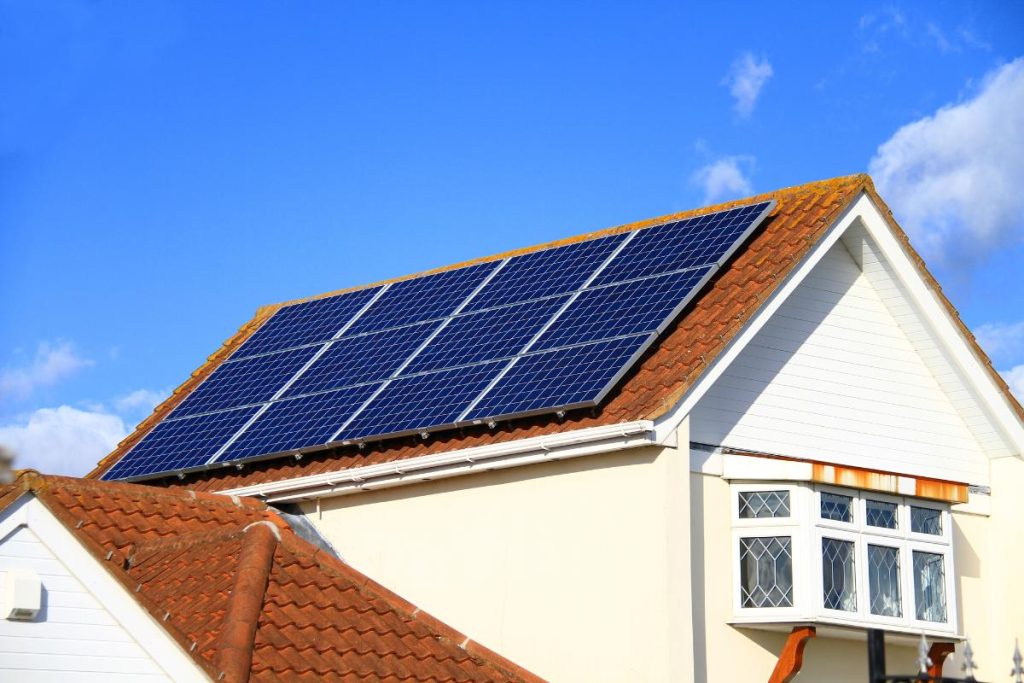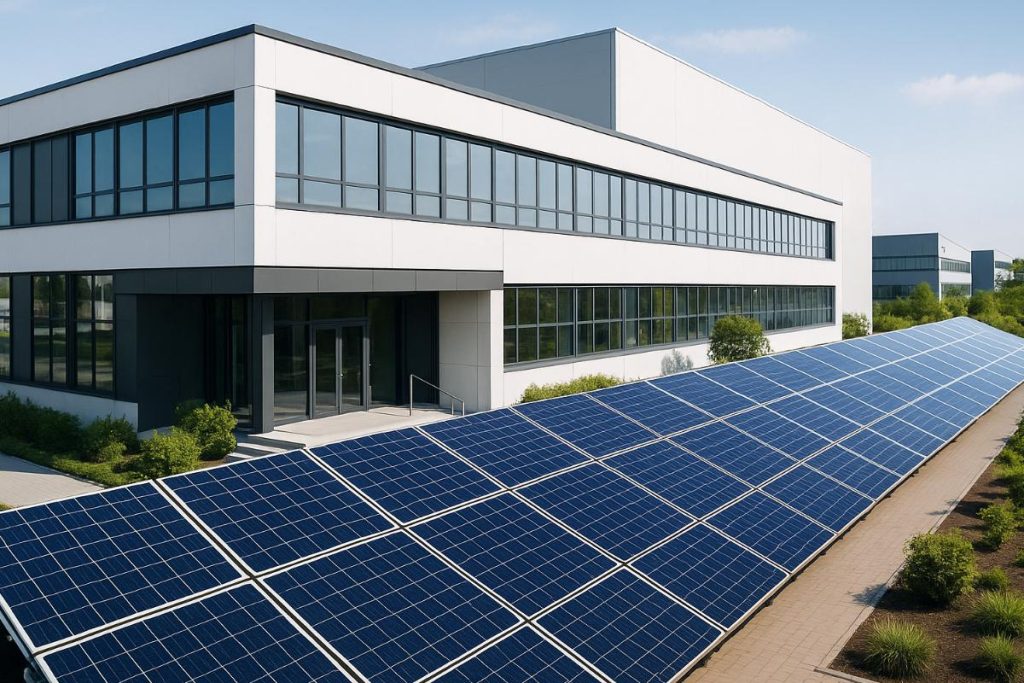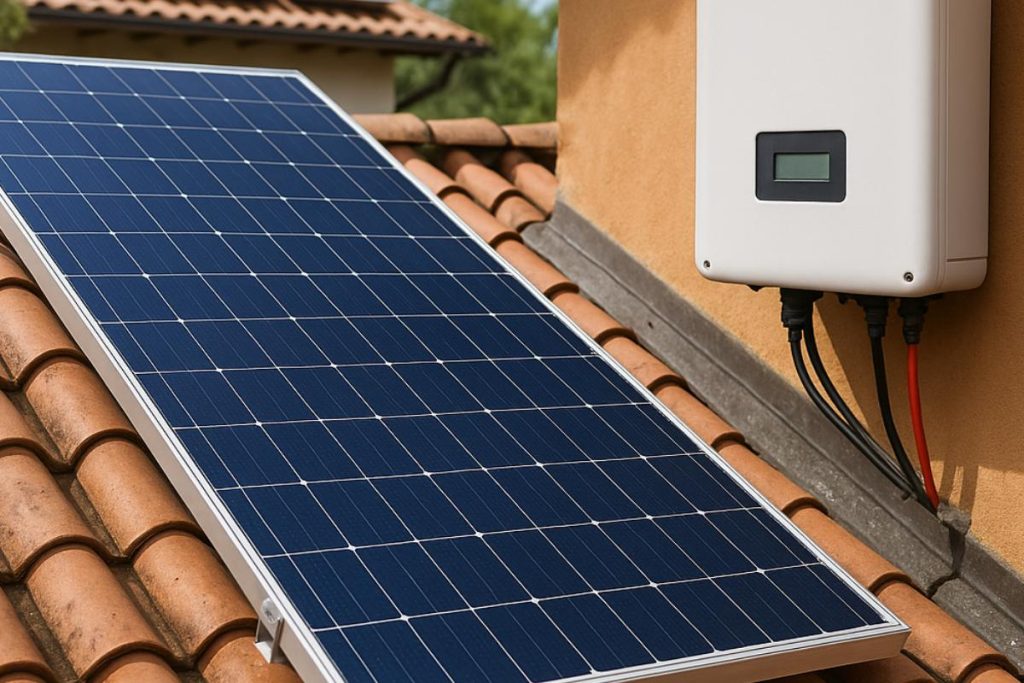Residential solar energy is becoming increasingly accessible and popular among Brazilians. How much does it cost to install solar energy at home? This is a common question asked by people who want to save money on their electricity bills and invest in sustainability. The cost of a domestic photovoltaic system may seem high at first glance, but it is important to understand that it is a investment which pays for itself with the savings generated and increases the value of the property.
In this comprehensive guide, we will explain in detail the residential solar energy costswhat influences prices and why this solution it's worth it in the long term. You'll see practical examples of values, learn about the factors that make up the budget (panels, inverter, installation, etc.) and find out how many years the system will take to complete. is paid with the reduction in electricity bills. We will also discuss financing options and tax incentives that make purchasing easy. At the end of the day, you'll be ready to take the next step towards energy independence in your home and start saving money for real!
How much does it cost to install residential solar energy?
The cost of a residential solar energy system varies depending on the size of the system and the characteristics of the project, but on average it is between R$15 thousand and R$30 thousand for an ordinary home. This value is usually includes all equipment, design and labor installation.
In recent years, prices have fallen significantly, with the price of residential solar panels dropping by around 60% between 2022 and 2025making solar energy more accessible than ever.
Here are a few practical examples of costs for different household consumption profiles:
Small household (low monthly consumption, ~200 kWh)
You may need a ~2 kWp system (about 4 panels), costing around R$10 thousand to R$12 thousand installed. This system generates partial savings on the electricity bill, reducing much of the monthly expense.
Average household (consumption ~500 kWh/month)
A 5 kWp (approx. 10 panels) costs around R$15 thousand to R$20 thousanddepending on the brand and equipment. With this size, it is possible to supply practically all of a family's average consumption and the electricity bill drops by up to 95%.
For example 5 to 8 kWp can cost between R1TP4Q13 thousand and R1TP4Q18 thousand currently, with the potential to generate R$400-700 in bill savings every month.
Large residence (high consumption ~1000 kWh/month)
You need a bigger system, around 12 kWp (20 to 24 panels). The investment is around R$25 thousand to R$30 thousand to meet this high consumption. This robust system practically eliminates a very high electricity bill, providing great savings.
Houses with average consumption (e.g. ~300 kWh per month, electricity bill around R$300) usually invest around R$20 to R$30 thousand in a photovoltaic system that covers almost all consumption. For businesses or industriesThe systems are larger and cost more, but here we focus on the residential segment. It's important to note that the figures above take into account all the components (photovoltaic modules, solar inverterand complete installation by specialized professionals.
Despite the initial investment, solar systems get cheaper every year due to technological developments and economies of scale. In addition electricity bill In other words, those who install solar energy today are protecting themselves against future energy inflation. In the following topics, we'll detail the factors that make up these costs and show how the investment pays back in the form of savings.
Factors that influence the value of solar energy
Several factors determine how much does a residential solar energy. Understanding these factors helps explain why budgets can vary from house to house:
System size (power in kWp)
This is the main factor. The more energy you want to generate (to cover higher consumption), the more solar panels you will need and the higher the total cost. Larger systems require more modules and a higher capacity inverter, raising the price. On the other hand, small systems to partially reduce the bill cost much less.
Energy consumption and household profile
The size of the system depends on the household's monthly consumption. A family that uses 300 kWh/month will need a modest system, while one that uses 1000 kWh/month will need a system several times larger.
Areas with high solar incidence (such as the Northeast of Brazil) allow more energy to be generated with fewer panels, reducing the size (and cost) of the system required. Therefore, geographical location and the level of solar irradiance influence the value: in very sunny places, a smaller system will do the trick, while regions with less sun may require a slightly larger system to generate the same amount of energy.
Components and quality of equipment
The solar panels account for most of the cost. There are panels of different technologies and efficiencies; high-efficiency panels (such as the latest generation of monocrystalline panels) cost more, but generate more energy in less space. O inverterThis system, which converts energy for use in the grid, also varies in price depending on the brand and features (hybrid models or those with advanced monitoring tend to be more expensive).
Also included in the package are fixing structures panels, cables, connectors, electrical protections (such as string boxes and circuit breakers) and other items. Opting for top quality equipment may increase the initial investment a little, but it brings benefits: greater efficiency and durability. For example, solar kits with products from renowned manufacturers tend to have better performance and a longer warranty.
A BYD, for example, is renowned for the high durability and efficiency of its modules and batteries, which results in more energy generation and less maintenance over the years. In a nutshell, quality comes at a costBut it also offers greater peace of mind and long-term savings.
Complexity of the installation
Every home has different conditions. Roofs that are very steep or difficult to access may require more time and safety equipment for the installers, increasing the cost of labor. Similarly, if the roof is fragile or old (such as very old tiles), it may be necessary to reinforce or repair the structure before fitting the panels.
The type of roof (flat slab, ceramic tile, metal) also influences the ease of installation and the type of support structure required. Another point is the distance from the connection point (longer distances require more cables and work, slightly increasing the cost. In short, simple installations (accessible roof, suitable structure) tend to be cheaper than those with technical challenges.
Projects and mandatory procedures
To connect the system to the electricity grid (in the case of on-grid systems), you need to submit a project and apply for approval from the power utility. Generally, solar energy companies take care of this homologation with the distributor, but any fees or adjustments requested can be included in the budget.
For example, it is sometimes necessary to change the light clock/entry standard from the house to a bidirectional model (which accounts for the energy injected into the grid). This type of adaptation usually comes at a cost, as does the issuing of technical reports. For larger systems, the following may be required access opinionsThis adds to documentation costs. In ordinary homes, these bureaucracies are simpler, but they are still part of the process.
Please note that when requesting a solar energy budgetIt's interesting to ask for a breakdown of the separate costs: how much is for the equipment (solar kit) and how much is for the installation services. That way you know exactly what you're paying for each component. In the same way that you buy an air conditioner and pay for the installation separately, it's the same with solar, so understanding the difference avoids overpaying for the services.
In general, serious companies will give you a price that includes everything, but it's fine to ask for the cost of the kit and installation separately to be transparent.
Extra costs in a residential solar project
In addition to the main system items (panels, inverter and structure), some projects may involve extra costs specific. These are generally aspects related to preparing the house to receive the panels or to regularizing the system. The main ones are:
1. Adaptation of the power input standard
In some installations, it is necessary to update the input standard (the point where the house connects to the electricity grid). This may involve changing the meter to a bidirectional model, increasing the capacity of the main circuit breaker or other adjustments to meet the utility's standards. These modifications ensure that the house can safely inject solar energy into the grid
2. Roof structural report
To ensure safety, especially in larger installations, it may be advisable to hire an engineer to assess the roof structure. The professional will check that the roof can support the weight of the panels and structures without problems. In most residential cases the weight is well distributed and there is no need for reinforcements, but in very old or damaged roofs some intervention may be necessary.
3. Approval and improvements to the electrical network
The energy distributor assesses the solar project before connection. In some cases, they may request improvements to the local network, such as changing the transformer or cables, especially if it is a microgeneration in a rural area or a larger system.
For typical residential systems, this rarely generates a significant cost to the consumer, but it's good to be aware of it. There may also be an inspection or survey fee from the utility company after installation (varies depending on the company and region).
4. Documentation and licenses
As a rule, residential solar energy systems no require an environmental license. However, it is necessary to obtain the access opinion from the utility company and sign a contract to sign up for distributed generation. The installation company usually takes care of this, including it in the package.
For large installations or specific cases, there may be a need for a municipal permit or other documents, but again, for standard homes there are usually no significant permit costs.
All these points are part of the planning and, where applicable, should be taken into account in the total budget. A good solar system integrator will advise you on each extra requirement and include these items in the proposal, avoiding surprises later on.
Savings generated and return on investment
Installing solar energy at home provides immediate savings on your electricity bill. A well-dimensioned system can reduce 95% the amount of the monthly energy bill, making the consumer pay only the minimum availability fee to the utility (which is usually around R$50 to R$100 for households, depending on the region).
In practice, this means saving hundreds of dollars every month. For example, if your current electricity bill is R$500, it could drop to around R$50a saving of R$450 per month. This relief in the household budget accumulates over the course of the year, in 12 months there would be ~R$5,400 saved, in the case of this hypothetical example.
With these savings, the return on investment in solar energy happens in just a few years. On average in Brazil, a residential photovoltaic system pays for itself in around 3 to 8 years. The exact time varies depending on a number of factors: the amount invested, the monthly savings generated (which depends on the sun in the area and the local energy tariff) and possible adjustments to the electricity bill. Currently, many residential installations already achieve payback close to 3 to 5 yearsthanks to the falling price of equipment and high electricity tariffs. In other words, in around 3 years the owners recoup every dollar invested in the form of reduced bills, and after that they continue to save for another two decades or more.
Example of payback: Suppose you invest R$20,000 in a solar system. If this system generates an average saving of R$4,000 to R$5,000 per year on your electricity bill, in approximately 4 to 5 years the investment will be fully recovered. Considering that solar panels have a lifespan of 25 years or olderyou would have at least 20 years of practically free energy after payback, resulting in tens of thousands of reais in net savings.
Few investments have such a guaranteed and long-lasting return! What's more, solar energy works like a protection against inflationWhile electricity tariffs rise year on year, those who generate their own energy are immune to these increases, further boosting savings over time.
Another indirect financial benefit is the property valuation. Houses equipped with a photovoltaic system tend to be worth more on the market, since the new owner will inherit a very low electricity bill. This can be a differentiator when it comes to a future sale. Studies indicate that the presence of solar energy can increase the resale value of the property due to the attractiveness of already having cheap energy installed.
Not to mention the environmental benefits, although the focus here is on the economic aspect, it is worth remembering that solar energy drastically reduces CO₂ emissions, contributing to a more sustainable future, which for many consumers also adds value to the investment.
Financing and incentives for solar energy
For those who want to install solar energy but can't or don't want to make the entire payment upfront, there are various financing options on the market. Many public and private banks offer specific credit lines for solar energy, with easy conditions. In some cases, it is possible to finance up to 5, 6 or 7 years old with low interest rates. The big advantage is that the financing installment can be close to (or even lower than) your electricity bill before, meaning that instead of paying the utility company, you pay the bank's installment and already enjoy solar energy.
For example, simulations show that a 5 kWp system (~R$13,000) financed over 60 months would have an installment of around R$550, while the savings on the bill would be around R$400 per month. With longer terms, the installment decreases even more, and could equal the savings generated. This means that the system pays for itself with the economy from the first month, without increasing your monthly expenses. Once you've paid off the loan, the savings are all yours.
It is worth researching options for financing solar energy in banks such as BNDES, Caixa, Banco do Brasil, credit cooperatives and even fintechs, which already have products focused on renewable energy.
In addition to easy credit, there are tax incentives and regulations that make solar energy even more attractive. Since 2015, the energy injected into the grid by the solar system (in the compensation scheme) has ICMS exemption in all Brazilian states, thanks to a national agreement, this guarantees that you don't pay ICMS on the energy you generate and deliver to the grid.
There are also PIS/Cofins exemption on compensated solar energy, in accordance with Law 14.300/2022 (GD Legal Framework). In practice, these exemptions mean more energy credits for you to write off on your bill, speeding up the return on your investment. Another important incentive is in the production chain: solar energy equipment can count on reduced import taxes and IPI through government programs (for example, the PADIS for solar energy components), lowering the cost of panels and inverters on the domestic market.
For systems with storage batteries (which allow solar energy to be used even at night or in the event of a power outage), there has also been great progress: the batteries have fallen by ~90% in price over the last decade and a halfmaking it feasible to equip homes with hybrid systems (panels + batteries) for greater autonomy. In fact, many consumers seek this solution after blackouts, as solar systems with batteries prevent losses during power grid failures. This is a growing market supported by research and development incentives, of which BYD is a global leader.
With all these facilities, financing, tax exemptions and technological innovation, it's much easier to invest in solar energy today than it was a few years ago. The federal government, banks and companies are engaged in popularizing solar energybecause it brings economic and environmental benefits to society as a whole.
Is it worth investing in residential solar energy?
As we have seen, the cost of residential solar energy should be seen as a smart investment. The initial amount, which is around a few tens of thousands of reais, quickly turns into saving on electricity bills. In just a few years, the investment pays for itself and you enjoy practically free electricity for the rest of the system's useful life (which can be 25 years or more). What's more, you protect your budget against tariff increases, increase the value of your property and contribute to a cleaner planet.
In a nutshell, it's worth installing solar energy at home for those who can afford it, either with their own resources or via financing. Every dollar invested comes back multiplied in the form of reduced future costs. And with equipment prices falling and incentives available, the barrier to entry has never been lower.
If you're interested in taking advantage of these benefits, the next step is to get a personalized quote for your property. BYD Energia, a leader in clean energy solutions, offers complete solar kits with superior quality and a network of trained partners throughout Brazil.
Start saving on your electricity bill now, request a quote of residential solar energy with BYD and discover how your investment can pay for itself in just a few years, bringing economy and sustainability for your daily life. Take advantage of this opportunity to generate your own energy and stay in control of your bills!
Frequently asked questions about residential solar energy
How much does it cost to install solar energy in a home?
The cost depends on the size of the system and the consumption of the house. On average, installing solar energy in a home costs between R$15 thousand and R$30 thousand to meet the majority of consumption. Smaller systems, which partially reduce the bill, can cost from ~R$10 thousand. Larger systems, on the other hand, can cost up to R$40,000 or more. This amount usually includes the panels, inverter, structure, design and complete installation.
Each case is different, so it's important to get a personalized quote. But in general, prices today are very affordable compared to years ago, and there are financing options to make the purchase easier.
How much does it cost to maintain a solar energy system?
A maintenance of a photovoltaic system is simple and inexpensive. Solar panels require virtually no complex maintenance. cleaning A basic cleaning every 6 months or 1 year, to remove dust, leaves and dirt that could reduce efficiency. This cleaning can be done by the owner themselves with water and neutral soap (taking due care to ensure roof safety) or by hiring a company, whose service is usually inexpensive. It is also important to monitor energy production, which can be done via the solar inverter's app or portal. If you notice a significant drop in generation or an alert in the system, you should call a technician for an inspection, but problems are rare.
Solar inverters are generally guaranteed for 5 to 10 years and may need to be replaced or repaired after about 15 years of use, which is a cost to consider in the very long term. Other than that, there are no moving parts and no input consumption, so maintenance comes down to periodic inspections and cleaning. In summary, maintaining a solar system costs very littleespecially when compared to the savings it generates.
Is residential solar energy really worth it?
Yes, residential solar energy is very worthwhile in most cases. Despite the initial investment, the benefits are worth it: you can save up to 95% on your electricity billYou're practically immune to constant tariff increases. The return on investment comes in just a few years (usually 3 to 8 years) and after that the savings are in your pocket.
In addition to the financial aspect, there are other advantages: you increases the value of your property (houses with solar panels are more attractive on the market) and contribute to the environment by using a clean, renewable source. Today, solar energy is one of the investments with the best returns, comparable or superior to many financial investments, but with practically zero risk (after all, the sun rises every day!). In fact, even those who don't have the money upfront can take out a loan, paying the installments with the savings on their electricity bills.
There are two main types of solar systems: on-grid (connected to the grid, without batteries) and off-grid (independent, with batteries). For homes in the city, the on-grid system is the most common and advantageousThe grid acts as a virtual battery and you only pay the minimum utility fee when you use solar energy. In remote locations without a power grid, a off-grid system with batteries allows you to have electricity, in these cases it's also worthwhile, as the alternative (such as a diesel generator) is often more expensive and polluting. In short, it's almost always worth installing solar energy at home, either for the savings or for the energy autonomy you gain.
What are the disadvantages of photovoltaic solar energy?
The main disadvantages of solar energy is the fact that it doesn't generate energy at night and produces less on very cloudy days. In other words, a conventional on-grid solar system on its own will not keep the house powered at night or during a blackout (in this scenario, the house will depend on power from the grid).
However, this can be circumvented by using storage batteriesThis forms a hybrid system. With batteries installed, surplus energy from the day is stored for use at night or in emergencies, guaranteeing a supply even if the grid goes down. Another disadvantage is the high initial investmentAlthough prices have fallen a lot, it's still a considerable expense and may not fit into everyone's pocket if there's no financing.
However, it's worth remembering that there are specific lines of financing that make it possible for most people to acquire the system, and the financial return is well worth the investment. In some cases, you also need roof or ground space to install the panels, which can be a limiting factor for apartment dwellers (although there are collective solutions, such as solar energy in condominiums or solar farms).
In short, the disadvantages of photovoltaic solar energy can be overcome: the intermittency (no sun at night) can be solved with batteries, which are increasingly affordable thanks to the 90% drop in costs over the last 15 years, and the initial cost is paid off in a few years, as well as being financeable. On balance, the positives far outweigh these limitations for the vast majority of consumers.

